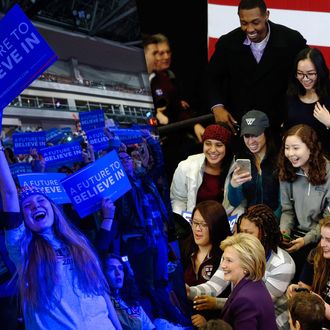
If there’s one narrative that’s reinforced by the vote in the Iowa caucuses — and most likely the vote tonight in the New Hampshire primary — it’s that Bernie Sanders is the favorite by an astonishing margin among the millennials who participated in those states’ nominating contests. But a lot of the excited “tomorrow belongs to Bernie” or to “Bernie’s brand of politics” claims we are hearing could be premature. His big millennial margins have been in states with very few nonwhite voters. And as we all know, that is about to change the minute the New Hampshire celebrations end.
What hasn’t gotten much attention, though, is that the reasonably well-established nonwhite voter preference for Hillary Clinton over Bernie Sanders is also going to affect the millennial category as we get beyond the exceptionally pale electorates of Iowa and New Hampshire. The reason is simple enough: Millennials are the most diverse of the commonly identified generational cohorts, with 43 percent of them being nonwhite. Nonwhite millennials are also more prone to identification as Democrats, and they vote Democratic in significantly higher numbers (Mitt Romney actually carried white millennials in 2012). So it’s not a reach to guess that nonwhites could form a majority or near-majority of millennials voting in Democratic primaries nationally.
Yes, there are signs that nonwhite millennials are much more open to the Sanders appeal than are older nonwhite voters. But even a Reuters analysis that’s widely in circulation to show the strong nature of Sanders support has him carrying about 38 percent of black voters under 30. That’s good, but not the stuff of generational ownership.
Will “the Bern” be felt more deeply by nonwhite millennials as they get to know the Vermont senator? Perhaps, but there’s no particular reason to assume it; Sanders’s support levels have not monolithically gone up in direct relationship with his name ID. So it might be a good idea to wait for a few more primaries to make generalizations about millennial voting patterns in 2016, much less years into the future. The best bet is that while Sanders may maintain a significant margin among young voters throughout the nominating process, it’s not going to look as monochromatic after states like South Carolina weigh in. So let’s at least wait that long before awarding the future.






























